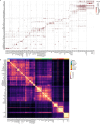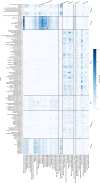Chromatin accessibility during human first-trimester neurodevelopment
- PMID: 38693260
- PMCID: PMC12589128
- DOI: 10.1038/s41586-024-07234-1
Chromatin accessibility during human first-trimester neurodevelopment
Abstract
The human brain develops through a tightly organized cascade of patterning events, induced by transcription factor expression and changes in chromatin accessibility. Although gene expression across the developing brain has been described at single-cell resolution1, similar atlases of chromatin accessibility have been primarily focused on the forebrain2-4. Here we describe chromatin accessibility and paired gene expression across the entire developing human brain during the first trimester (6-13 weeks after conception). We defined 135 clusters and used multiomic measurements to link candidate cis-regulatory elements to gene expression. The number of accessible regions increased both with age and along neuronal differentiation. Using a convolutional neural network, we identified putative functional transcription factor-binding sites in enhancers characterizing neuronal subtypes. We applied this model to cis-regulatory elements linked to ESRRB to elucidate its activation mechanism in the Purkinje cell lineage. Finally, by linking disease-associated single nucleotide polymorphisms to cis-regulatory elements, we validated putative pathogenic mechanisms in several diseases and identified midbrain-derived GABAergic neurons as being the most vulnerable to major depressive disorder-related mutations. Our findings provide a more detailed view of key gene regulatory mechanisms underlying the emergence of brain cell types during the first trimester and a comprehensive reference for future studies related to human neurodevelopment.
© 2024. The Author(s).
Conflict of interest statement
Competing interests: S.L. is a paid scientific adviser to Moleculent, Combigene and the Oslo University Center of Excellence in Immunotherapy. All other authors declare no competing interests.
Figures














References
-
- Braun, E. et al. Comprehensive cell atlas of the first-trimester developing human brain. Science382, eadf1226 (2023). - PubMed
-
- Trevino, A. E. et al. Chromatin and gene-regulatory dynamics of the developing human cerebral cortex at single-cell resolution. Cell184, 5053–5069 (2021). - PubMed
-
- Siletti, K. et al. Transcriptomic diversity of cell types across the adult human brain. Science382, eadd7046 (2023). - PubMed
MeSH terms
Substances
LinkOut - more resources
Full Text Sources

